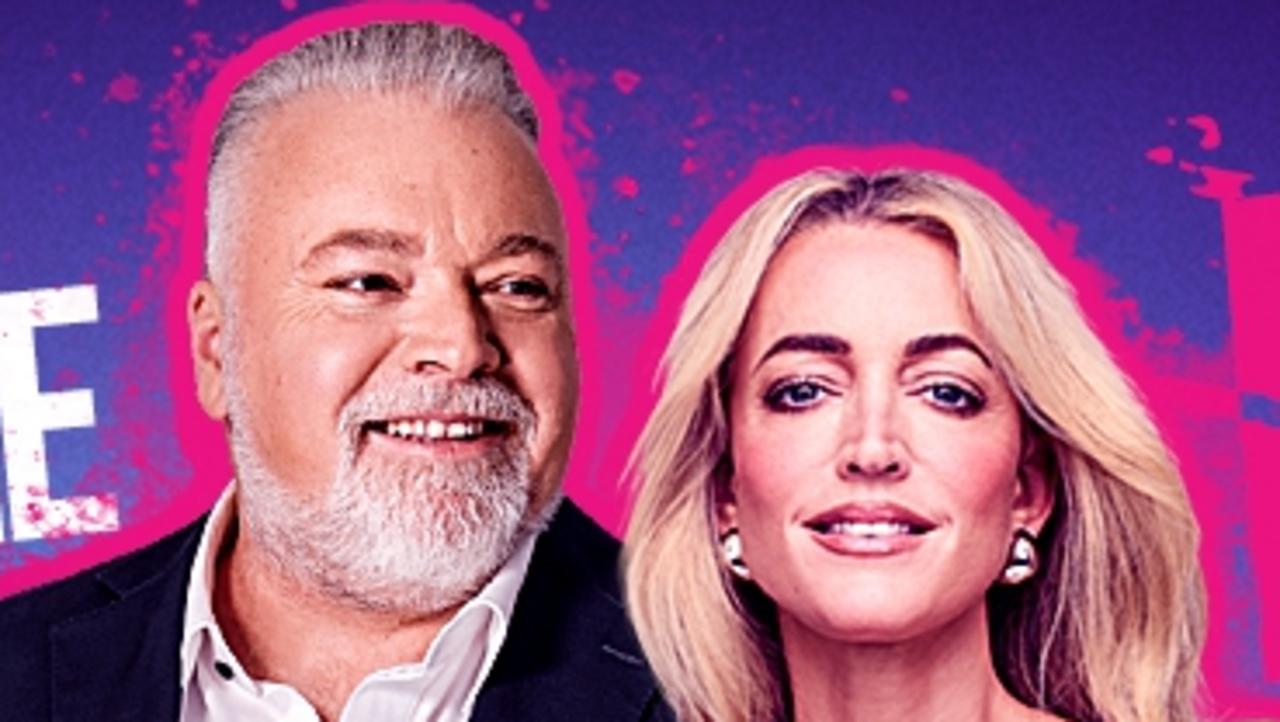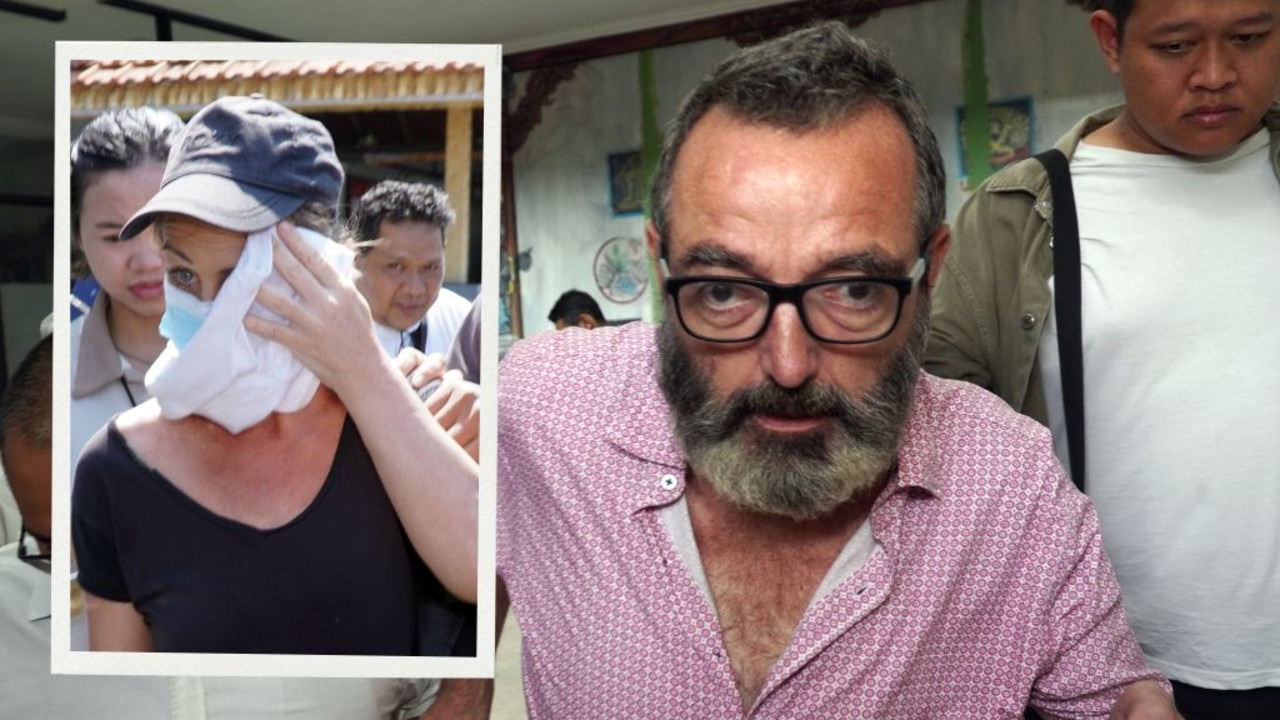Dogs’ legend Brad Johnson talks coaches, why he owes Brian Taylor ‘a hell of a lot’ and life after footy
Bulldogs champ Brad Johnson played 364 games but never in a grand final - and he’s OK with that. Now he has a new purpose, helping female footballers stay safe.
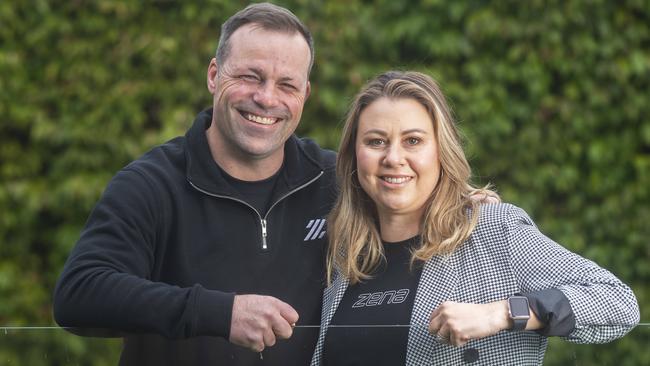
News
Don't miss out on the headlines from News. Followed categories will be added to My News.
Brad Johnson is one of the most unassuming 350 game players you will meet. He is a record holder for the Western Bulldogs, a six-time All Australian including captaincy and is universally respected and admired. We spoke about nicknames, the decathlon, finding his feet in the AFL, Terry Wallace, Rodney Eade, and his new venture with his wife Donna that helps young woman in sport.
HM:Johnno, are you ever not smiling?
BJ: Of course. If you were to ask Donna and the kids, I’m not always smiley and happy but I try to. Generally, I try to enjoy life as much as we can.
HM: Who called you the “smiling assassin?”
BJ: That was Rex (Hunt), back in the day when he was on fire with all his terminology. He was the one that started it.
HM: When did you know that you were going to spend the bulk of your life playing football? Were you a gun junior?
BJ: I was OK. I played at Hoppers Crossing, and I loved it. I played under 13s, 14s and 15s there. There were a few guys that were a lot better than I was, and they were great juniors to play with. I always wanted to play footy, I loved my athletics and basketball growing up as a youngster as well, but athletics was my favourite.
HM: Were you so talented that you could have gone down either path?
BJ: I loved the 400m, 800m and 1500m. I loved my hurdles and worked out quickly as the hurdles got bigger that I didn’t have the flexibility to get over them as well as I would have liked. When I was jumping over the smaller ones, it was good fun. I represented Werribee a few times, you go to the titles at Olympic Park, but as I got older, I ventured into the decathlon space where you were doing five events at the championships. I got bored easily waiting around four hours to run a heat, so why not pick five events and have a crack at those. The distance suited me, sprinting was OK, the only one I struggled in was discus, I couldn’t throw. Daley Thompson was my favourite athlete – he was an idol of mine.
HM: When did you give up your decathlon hopes and focus on football?
BJ: I was 15, and I had to decide what I wanted to do with my footy. I was more outside, and a little bit soft in the way I played the game. I had to toughen up, so I went and played with the Williamstown U/19s as a 15-year-old. I was lucky enough to make their list, and in my years at 15 and 16, I played with Williamstown in the VFA. I played four reserves games and learnt a fair bit in that 12 months about where I was at with my footy. The following year, I went back to the Western Jets and played against kids my own age again. I was confident, my game had changed and I was drafted as a 17-year-old.

HM: Who told you that you were going to the Bulldogs?
BJ: Mark Kleiman. I spoke to a few clubs in my draft year, and the Dogs rang me the night before the draft. All that was said to me was, “If you’re still around tomorrow, do you want to come to the Dogs?” I said, “Of course”. That was it. He hung up the phone.
HM: When you arrive at the club, you’re 17 years old. Am I right in saying the first bloke you ran into was Doug Hawkins?
BJ: Dougie Hawkins greeted me at the door. The new kid on the block was met by a legend. He sat me next to him at locker number 6, but I was quickly shuffled to the other side of the locker room to number 33, which was still an honour at the time as it was Brian Royal’s old number. All of us young draftees sat together and had to find our way quickly in a room of strong characters. When you walk in as a 17-year-old, and you’re 5’11 with no weight on you, it’s daunting.
HM: Who had a big impact on you?
BJ: Terry Wheeler said to me when I first walked in: “Align with some players that are a little bit older than you, that can help you fast track.” I was lucky that Westy, Smithy and Granty were those three guys that were a little bit older than me. I jumped on their backs and followed them around everywhere. Steve Wallis, along with Smithy, would spend hours after each training session working with me on my kicking. It was average, it wasn’t AFL standard in the early days. I had to do a lot of work on it. In that first year, Wally put a huge amount of time into that side of my game, which was awesome.
HM: And Brian Taylor was helpful to you?
BJ: I owe BT a hell of a lot. Terry Wallace made the call to take me from the midfield and play me as a permanent forward. The way the game was played was one-on -ne, out of the goalsquare. Brian was employed by the club on a part time basis, and he was enormous. He spent every training session with me, he was out on the ground with me, yelling instructions to me, educating me, teaching me.
HM: You mentioned you didn’t have an AFL-standard kick upon arrival. You played 364 games, six-time All-Australian, three-time best and fairest. At what point did you think to yourself, I might be OK, and able to get through all the uncertainty, fear, and anxiousness?
BJ: It takes some time. The anxiousness never leaves you, that’s something that stays throughout your career. You back in your preparation, and everything that goes with it, but you doubt yourself. You become calmer once you run out onto the ground, but it’s the lead up to match day that fills you with anxiousness. That stayed with me my whole career. It’s not until five or six years in when you start to feel confident. You get to a good strength level with your body, and size, and gain an ability to work out various scenarios in games.
HM: A Brownlow medallist once said to me, “You’re terrified you’re never going to make it at the start, and then when you get regular games, you’re worried that you won’t be able to maintain your standard. Then when you get old, you’re terrified your body is going to let you down, and every game is going to be your last”.
BJ: That’s exactly how it works. You go through those early development phases, and you get some strong life lessons in footy, it’s about how you react to those. Handling feedback, being dropped, and learning along the way.
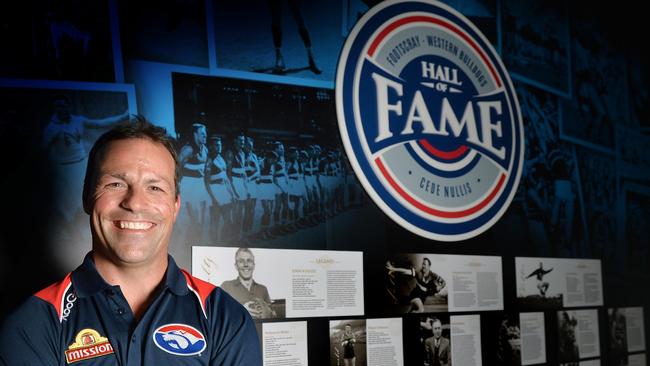
HM: It’s amazing when you look at the best careers. The best players can maintain excellence for so long. If you look and think about who the best player of the modern era is, who would you say?
BJ: I’ve loved what Buddy Franklin has done, he’s been unbelievable as a player. Gary Ablett Jnr was enormous all throughout his career, unbelievable consistency. They’re the two I’ve watched the most. I played against them for the start of their careers, and since just kept watching them.
HM: Who was the defender that, when you knew he was on you the following week, you were in for a sh--storm?
BJ: Every one of them. It was a mixture. I always had some strong battles with Cameron Bruce from Melbourne. He’d run off me all the time, take me out of position, and was dangerous to play against. Tom Harley was ridiculously tough to play against, just with his size and strength. Trying to exploit a player like that was extremely difficult. Harry Taylor was the other one from Geelong. When I was finishing up, he was very difficult to play against, and very physical. They were the toughest for me.
HM: Am I right in saying you had (as coaches) Terry Wheeler, Alan Joyce, Terry Wallace, Peter Rohde, and then Rocket?
BJ: That’s right.
HM: Were you always taken by Terry’s tan?
BJ: I learnt my lesson early days, that I don’t mention anything about that with Plough. He was an amazing coach and he got me going in my career no question.
HM: He is a beauty. Of all the coaches I’ve seen who can give a spray, Rodney looked to be in the top echelon.
BJ: Leaving Sydney and coming to the Bulldogs, Rocket learnt a fair bit about his own coaching in that period. He was a strong coach, and extremely passionate about where he wanted us to be as a football club and passion can spill over at times. I know that everybody sees the emotion in the coach’s box but he was really composed in terms of his message delivery, and tactically what he wanted us to achieve as a group. We didn’t let him down too much and those frustrations were minimised a little bit in his stint at the Bulldogs. He took us to a level that we didn’t really expect to get to. As a 28-year-old, when Rocket turned up, I thought my footy was at the level it would be at to see out my career. He took my game to another level. Everyone cops a spray or two along the way and that’s part and parcel of being involved in footy for a long period of time but the positives certainly outweighed the little whack we got every now and then for not living up to the standards that we all set.
HM: Ric Charlesworth, the great hockey coach said: “The interesting thing about coaching is that you have to trouble the comfortable, and comfort the troubled.” That is the aim. What did the best coaches you had, have?
BJ: They best have an edge about them, no question. I used to be nervous walking past the coach’s office. I never got too close with the coach. Rocket was a little bit of an exception as I was finishing up the last couple of years and being in that position as captain but leading up to that, the coach always had to be on edge. I’d always be nervous walking past the office. You’d walk past with your head down, and hope that you weren’t called in. I liked that I had a strong relationship with my coaches along the way but never got to that point of being comfortable with a coach. That kept me on edge no doubt. Rocket was great, he’d put the arm around you, but also grab your forearm, and as soon as he grabbed your forearm, you knew it was business with Rocket. He had his little triggers with us as players, and we understood those.
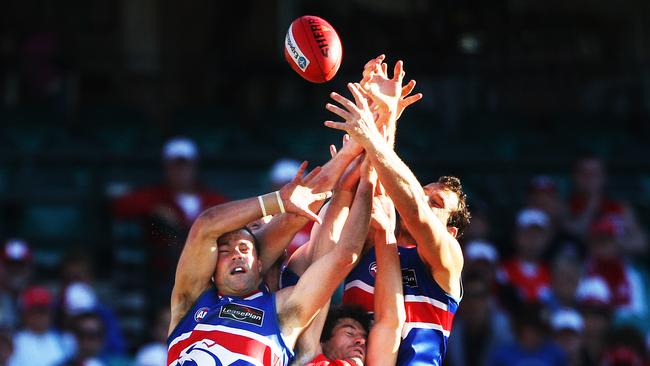
HM: Five preliminary finals. You were unbelievably close, a lot.
BJ: They were at different stages in my career. The early ones were 1997, 1998, and the last three were in ‘08, ‘09 and 2010. We finished 15th in 1996, then made a prelim the next year and lost by a point. We kicked six behinds in the last quarter. In ‘98, Andrew McLeod just turned one on. Then with those last three, ‘09 was the closest we got as a group, we were seven points up in the last quarter, then Nick Riewoldt went to work late and kicked a couple. We had our chances, we were so close to the last game of the season.
HM: You OK with that?
BJ: I think I am. As disappointing as it was to never play in a grand final, it sits comfortably knowing we tactically, and as a playing group, gave absolutely everything in those preliminary finals. We didn’t leave anything out on the park. We played some good teams throughout that three-year period, but just couldn’t get the result we wanted as a group. You look at every teammate that played on those days, and you’re unbelievably proud of what they were able to do.
HM: What do you miss most about footy?
BJ: When you first finish up, you do miss that locker room aspect, everyone talks about that, and it’s a true feeling. You are around 40 guys every day, you’re having fun, kicking the Sherrin around. You miss riding the emotions of footy with the playing group, and it takes an adjustment.
HM: Tears in 2016?
BJ: I didn’t cry, but the kids did. I was extremely emotional though. It was crazy scenes and being able to stand on the MCG when the players were awarded their medals, and then given the Premiership cup, was huge. Being in the changerooms, getting thrown in with the players to have a beer with them, it was great. I got to interview Chris Hemsworth after the grand final in the changerooms, that was a highlight. It was just an unbelievable day, and the next day was one of the best footy days of my life, having beers with the players, coaches, and celebrating the victory.
HM: How many of your former teammates, or opposition players, have really battled post footy with the transition?
BJ: Everyone has their own elements of that transition period. Some get through it better than others, but the reality is, it’s a huge transition to step out of the day to day. You live off that A4 piece of paper, you’re told exactly where you need to be for every session, for each function, what your week lives around and then suddenly that stops completely. I focused on myself to be honest.. I worked on different aspects, wanting to step into the media when I finished playing. The club was brave in allowing me to do that, and when I stepped away, I was able to stay in the game, because I am passionate about it.
HM: You seem to have found a good rhythm – It’s not often that a husband-and-wife combination can team up, in a business, remain happily married and have success.
BJ: It’s rare. The protective vests product was all Donna’s idea, and she is a great supporter of mine. That’s what I’m doing now. I’ve got that passion and drive again. It’s taken having our own business to really find that competitive drive again. It’s a different competitiveness, but it’s bloody competitive out there. I’m loving it.
HM: (Donna, Brad’s wife has been listening in as Brad and I have chatted.) Donna, was it your idea?
DJ: Yes, it was but this is Brad’s interview not mine.
HM: Not anymore, we’ve had enough of him. Anyway, it’s a big part of his life now. How did the Zena Impact Protection Vest for women come to be?
DJ: I was talking with my girlfriend on a Monday after sport on the weekend with the kids. It was when footy had exploded and girls were starting to play in huge numbers. Her three daughters had just started playing footy, and we were discussing injuries that had occurred on the weekend, how these girls were playing so hard, and didn’t hold back. I was talking about the fact that I couldn’t believe these adolescent girls were in such a crucial stage of their development, physically, and they weren’t wearing any form of chest protection.
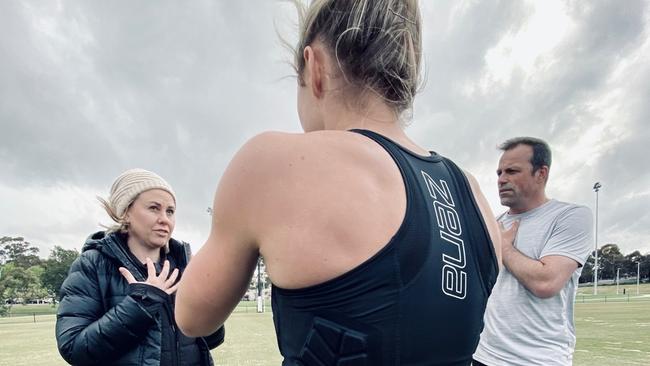
HM: How did the idea become a business?
DJ: I continued the chat with Brad and he encouraged me to investigate it. I spent the following days looking into it and there were no products on the market. I investigated research on breast injury and could hardly find anything. That’s when we set out to do our own research project, which we did. We interviewed everyone from coaches, professional girls, right through to parents, adolescents, across all sports. The results showed that breast and rib injury was a significant thing but no one was talking about it. It was going unspoken. We spent two years researching and developing the actual product, we developed our samples, trialled them and had amazing feedback.
HM: It’s a big leap to press go on production and start a business though.
BJ: Huge.
DJ: We had to make that decision as to whether we were going to give it a go, which we did, and five years on it’s turned into something I never would have imagined.
HM: It’s not only for breast protection – you talk about ribs, lumps, implants.
DJ: The first AFL girl to reach out to us was Ebony Antonio from Fremantle. She had some suspicious lumps in her breast, I knew she loved the product, so she wore it throughout her whole pre-season, and the regular season. I knew with her feedback it was going to be something that was going to be well received, which it has been. Since then, we contacted Daisy Pearce, and she wore it when she returned from breastfeeding the twins, and still does wear it. We have a lot of mums that have returned to sport that are breastfeeding, we have a lot of women with breast implants who have suffered with implant ruptures, which involves surgery. They can then return to sport knowing they are protected. We have other women with specific health issues, women returning having had double mastectomies from breast cancer, who are able to return to sport with a level of comfort.
BJ: Just the general confidence. There are a lot of girls that are just starting out in sport, so they wear it for that confidence factor as well.
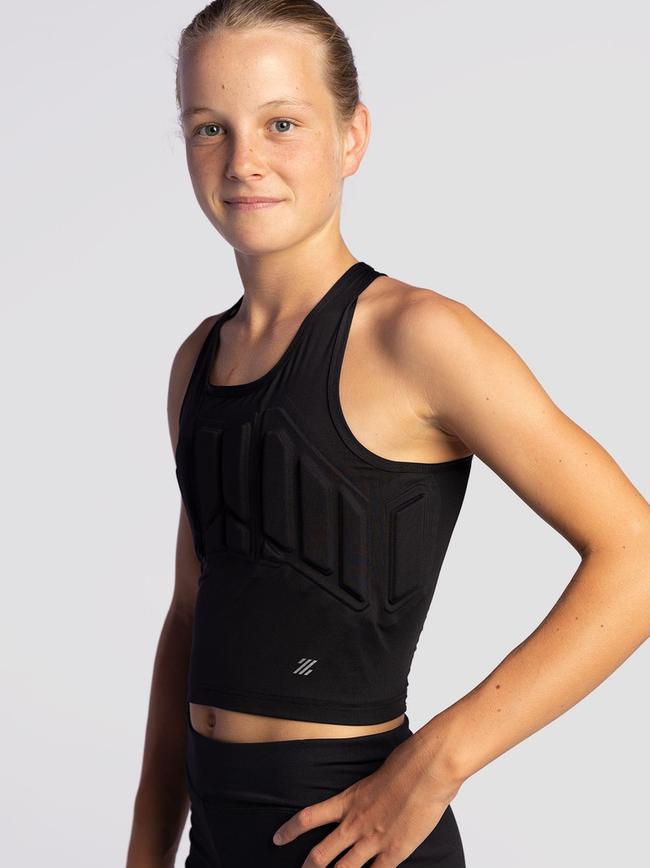
HM: Who is the CEO?
BJ: Donna.
HM: CEO and founder?
DJ: Both Brad and I are co-founders – he is so passionate about it and he’s a great advocate for women in sport. We both have our different roles and we try to stick to them as much as we can. We have kids doing the packaging, zipping, and checking. It’s become a real passion. I get just as excited seeing a professional athlete wearing it, as I do when I see a young girl wearing it on the weekend on the footy field. It’s so exciting – it’s gone from an idea for the AFLW players to over 25 sports including soccer, basketball, softball, lacrosse and goalball.
HM: Is there any reason why the T20 players won’t be wearing these?
BJ: Not really. We will keep evolving. With all the feedback that we have been getting, we decided to then release our youth vest, which is for girls between eight and 13. We had such a great response to our adult version.
BJ: And now we are working with Deakin University. They’ve set up a sport research program, which has been brilliant for us, validating the impact of the padding. That has been important for us, talking to so many different athletes at different levels, having that support, studies behind us, as well as a business, has been critical.
Zena Impact Protection vests can be found at zenasport.com.au

